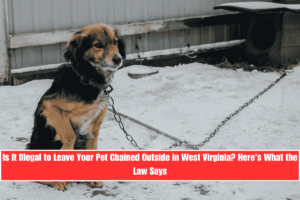Tethering, or chaining a dog, means tying the animal to a stationary object like a post or tree using a rope or chain. While this may seem like a way to control a pet, many U.S. states have placed laws or restrictions on this practice to protect dogs from cruelty and neglect.
As of 2022, 23 U.S. states and Washington, D.C. have specific laws regulating how and when dogs can be tethered. These laws are designed to make sure that dogs are not harmed or put at risk while tied.
States with Tethering or Chaining Laws
While each state has different rules, the following have statewide laws addressing dog tethering:
California, Connecticut, Hawaii, Indiana, Louisiana, Massachusetts, Michigan, Nevada, Oregon, Pennsylvania, Rhode Island, Washington, West Virginia, and the District of Columbia, among others (totaling 23 states as of 2022).
These laws may limit how long, what type of collar is used, what kind of tether, and weather conditions in which a dog can be tied.
Common Rules Across States
Even though laws vary, many states share similar guidelines. Here are the most common features:
Time Limits
Some states limit the number of hours a dog can be tethered:
- Massachusetts: No more than 5 hours
- Oregon: No more than 10 hours
- Nevada: No more than 14 hours
Collar Restrictions
Some states ban choke, pinch, or prong collars:
- Hawaii
- Rhode Island
- Others follow similar safety standards
Tether Length and Weight
Some states require that the tether:
- Be at least 3 times the length of the dog (Indiana, Michigan, Pennsylvania)
- Weigh no more than 1/8 of the dog’s body weight (Rhode Island)
- Not prevent normal movement (Washington)
Access to Essentials
Most states require that tethered dogs must have free access to:
- Water
- Food
- Shelter
And they must not get tangled while trying to move around.
Extreme Weather Restrictions
States have started making special rules after seeing pets suffer during storms, heatwaves, or cold snaps:
- Pennsylvania: It’s considered neglect if a dog is tied for more than 30 minutes in over 90°F or below 32°F.
- Connecticut & Massachusetts: In harsh weather or during official weather advisories, dogs can’t be tethered for more than 15 minutes.
- Louisiana: Bans tethering dogs or cats in emergency zones during extreme weather.
What If There Are No State Laws?
In states without specific tethering laws, general animal cruelty laws still apply. If a dog is suffering due to poor tethering conditions, it could still be a crime under neglect or cruelty laws.
Also, many cities and counties have their own local ordinances that limit or ban tethering even if the state doesn’t.
While it’s not illegal to tie a dog in every state, more than 20 states have created laws to limit how long and under what conditions a dog can be chained. The main focus of these laws is to prevent cruelty, injury, or death to animals left tied up for too long or in dangerous conditions.
If you’re a dog owner or simply care about animal welfare, it’s important to understand the local and state laws where you live or travel. When in doubt, always prioritize the safety, comfort, and freedom of your pet.
FAQ
Is it illegal to tether a dog in all 50 states?
No, but 23 states and Washington D.C. have specific laws regulating tethering. In other states, general cruelty laws may apply.
Which states ban choke collars for tethering?
Hawaii, Rhode Island, and others ban choke, pinch, or prong collars for tethered dogs.
How long can I legally tether my dog?
This depends on the state. Some states like Massachusetts allow no more than 5 hours, while others set longer or weather-based limits.
Can I tether my dog during bad weather?
In states like Connecticut, Massachusetts, and Pennsylvania, you cannot tether a dog for long in extreme heat, cold, rain, or storms.
What happens if I break tethering laws?
You could face fines or even criminal charges, especially if the dog suffers injury, neglect, or death.


















Leave a Reply